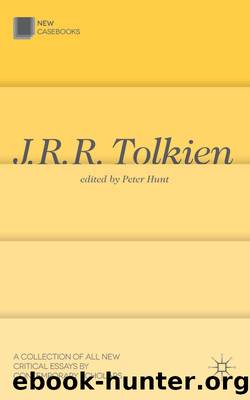J.R.R. Tolkien by Peter Hunt;

Author:Peter Hunt;
Language: eng
Format: epub
Publisher: Bloomsbury UK (Minor Textbooks)
7
Tolkien and Worldbuilding
Catherine Butler
What is worldbuilding?
One of Tolkienâs distinctive contributions to fantasy writing lies in the example he set as a builder of worlds. Fantasy and science-fiction novelists, game designers, and role-play enthusiasts all acknowledge Tolkien as a master in the art of constructing a universe with its own history and geography, flora and fauna, cultures and languages, magic and physics. Tolkien may be known as the builder of only one world â Middle-earth1 â but it is a world almost six decades in the making, and has a depth and detail to which other writers, whether for adults or children, can only aspire.
The labour of creating Middle-earth, in its various phases, revisions and versions, has become a subject of study in its own right, to which much academic attention has been devoted. It is no part of my present purpose to compete with the work of such scholars as Douglas A. Anderson, John Rateliff, Christina Scull, Wayne G. Hammond, and above all Tolkienâs son Christopher, whose editions of his fatherâs unpublished work, starting with The Silmarillion in 1977, have done much to enlarge and enhance our understanding of Middle-earthâs evolution. Rather, I wish to explore the implications and ramifications of the act of worldbuilding, especially as it was conceived and practised by Tolkien. In particular, this essay will consider the ways in which considerations of audience may have affected the representation of Middle-earth. The Hobbit and The Lord of the Rings are set in the âsameâ world, yet it looks quite different in important respects. How far should these differences be understood as reflecting the 17 years of development between their publication, and how far are they attributable to considerations of genre and of the capacities and interests of their respective audiences?
Worldbuilding and sub-creation
Tolkienâs most extensive statement on the art of making worlds comes in his 1939 essay âOn Fairy-Storiesâ, and this seems to the obvious place to begin our investigation. It is here that he introduces the concept of the writer as a âsub-creatorâ, a position analogous in some ways to that of God as the creator of our own world. For Tolkien, sub-creation arises from the imaginative ability of humans to recombine elements of reality (the âPrimary Worldâ) in new ways. When these recombined elements are arranged and expressed through art, they result in a new, Secondary World, which may in turn induce in readers the kind of imaginative absorption Tolkien refers to as Secondary Belief, and it is on the ability to evoke Secondary Belief that the Secondary Worldâs claim to be a successful sub-creation depends.
Given the nature of Tolkienâs own fiction, it is important to stress that the creation of a Secondary World in this sense is not in itself to be identified with the making of a world such as Middle-earth. Rather, a Secondary World may be an imaginative space of any kind, as long as that space is sufficiently well rendered to enable Secondary Belief. The world Thackeray conjures in Vanity Fair, for
Download
This site does not store any files on its server. We only index and link to content provided by other sites. Please contact the content providers to delete copyright contents if any and email us, we'll remove relevant links or contents immediately.
The Power of Myth by Joseph Campbell & Bill Moyers(940)
Half Moon Bay by Jonathan Kellerman & Jesse Kellerman(920)
A Social History of the Media by Peter Burke & Peter Burke(888)
Inseparable by Emma Donoghue(855)
The Nets of Modernism: Henry James, Virginia Woolf, James Joyce, and Sigmund Freud by Maud Ellmann(773)
The Spike by Mark Humphries;(730)
A Theory of Narrative Drawing by Simon Grennan(716)
The Complete Correspondence 1928-1940 by Theodor W. Adorno & Walter Benjamin(712)
Ideology by Eagleton Terry;(665)
Bodies from the Library 3 by Tony Medawar(656)
World Philology by(649)
Farnsworth's Classical English Rhetoric by Ward Farnsworth(648)
Culture by Terry Eagleton(648)
Adam Smith by Jonathan Conlin(620)
A Reader’s Companion to J. D. Salinger’s The Catcher in the Rye by Peter Beidler(616)
Game of Thrones and Philosophy by William Irwin(604)
High Albania by M. Edith Durham(598)
Comic Genius: Portraits of Funny People by(588)
Monkey King by Wu Cheng'en(583)
